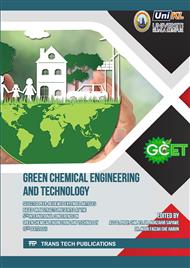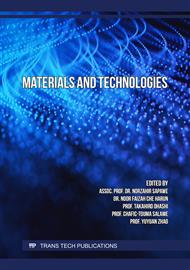[1]
World Health Organization, Iron in drinking-water. WHO Guidelines for drinking-water quality,, Who/Sde/Wsh/03.04/08, vol. 2, p.4, (2003).
Google Scholar
[2]
A. G. Tekerlekopoulou, S. Pavlou, and D. V. Vayenas, Removal of ammonium, iron and manganese from potable water in biofiltration units: A review,, J. Chem. Technol. Biotechnol., vol. 88, no. 5, p.751–773, 2013,.
DOI: 10.1002/jctb.4031
Google Scholar
[3]
N. Khatri and S. Tyagi, Influences of natural and anthropogenic factors on surface and groundwater quality in rural and urban areas,, Front. Life Sci., vol. 8, no. 1, p.23–39, 2015,.
DOI: 10.1080/21553769.2014.933716
Google Scholar
[4]
A. bin Jusoh, W. H. Cheng, W. M. Low, A. Nora'aini, and M. J. Megat Mohd Noor, Study on the removal of iron and manganese in groundwater by granular activated carbon,, Desalination, vol. 182, no. 1–3, p.347–353, 2005,.
DOI: 10.1016/j.desal.2005.03.022
Google Scholar
[5]
BLHK-Balikpapan, Laporan Status Lingkungan Hidup Daerah Kota Balikpapan,, (2015).
Google Scholar
[6]
V. Kumar, P. K. Bharti, M. Talwar, A. K. Tyagi, and P. Kumar, Studies on high iron content in water resources of Moradabad district (UP), India,, Water Sci., vol. 31, no. 1, p.44–51, 2017,.
DOI: 10.1016/j.wsj.2017.02.003
Google Scholar
[7]
N. Resources, Iron in Drinking Water DG035 2017,, p.2, 2017, [Online]. Available: https://dnr.wi.gov/files/PDF/pubs/DG/DG0035.pdf.
Google Scholar
[8]
Q. qing Zheng et al., Iron overload promotes erythroid apoptosis through regulating HIF-1a/ROS signaling pathway in patients with myelodysplastic syndrome,, Leuk. Res., vol. 58, no. 600, p.55–62, 2017,.
DOI: 10.1016/j.leukres.2017.04.005
Google Scholar
[9]
V. Alimohammadi, M. Sedighi, and E. Jabbari, Experimental study on efficient removal of total iron from wastewater using magnetic-modified multi-walled carbon nanotubes,, Ecol. Eng., vol. 102, p.90–97, 2017,.
DOI: 10.1016/j.ecoleng.2017.01.044
Google Scholar
[10]
E. A. Boyle, J. M. Edmond, and E. R. Sholkovitz, The mechanism of iron removal in estuaries,, Geochim. Cosmochim. Acta, vol. 41, no. 9, p.1313–1324, 1977,.
DOI: 10.1016/0016-7037(77)90075-8
Google Scholar
[11]
K. Kan, CC; Wan, MW; Chen, WH; Phatai, P; Wittayakun, J; Li, The preliminary study of iron and manganese removal from groundwater by NaOCl oxidation and MF filtration,, Heal. Environ. Res. Online, vol. 22, no. 1, p.25–30, (2012).
Google Scholar
[12]
S. Bordoloi, S. K. Nath, S. Gogoi, and R. K. Dutta, Arsenic and iron removal from groundwater by oxidation-coagulation at optimized pH: Laboratory and field studies,, J. Hazard. Mater., vol. 260, p.618–626, 2013,.
DOI: 10.1016/j.jhazmat.2013.06.017
Google Scholar
[13]
N. Khatri, S. Tyagi, and D. Rawtani, Journal of Water Process Engineering Recent strategies for the removal of iron from water : A review,, J. Water Process Eng., vol. 19, no. 13, p.291–304, 2017,.
DOI: 10.1016/j.jwpe.2017.08.015
Google Scholar
[14]
K.H. Choo, H. Lee, and S. J. Choi, Iron and manganese removal and membrane fouling during UF in conjunction with prechlorination for drinking water treatment,, J. Memb. Sci., vol. 267, no. 1–2, p.18–26, 2005,.
DOI: 10.1016/j.memsci.2005.05.021
Google Scholar
[15]
J.L. Lin, C. Huang, J.R. Pan, and Y.S. Wang, Fouling mitigation of a dead-end microfiltration by mixing-enhanced preoxidation for Fe and Mn removal from groundwater,, Colloids Surfaces A Physicochem. Eng. Asp., vol. 419, p.87–93, 2013,.
DOI: 10.1016/j.colsurfa.2012.11.053
Google Scholar
[16]
K. Jasiewicz and R. Pietrzak, The influence of pore generating agent on the efficiency of copper and iron ions removal from liquid phase by polyethersulfone membranes,, Chem. Eng. J., vol. 228, p.449–454, 2013,.
DOI: 10.1016/j.cej.2013.05.005
Google Scholar
[17]
X. Du et al., Removal of iron, manganese and ammonia from groundwater using a PAC-MBR system: The anti-pollution ability, microbial population and membrane fouling,, Desalination, vol. 403, p.97–106, 2017,.
DOI: 10.1016/j.desal.2016.03.002
Google Scholar
[18]
Y. Artioli, Adsorption,, Encycl. Ecol. Five-Volume Set, p.60–65, 2008,.
Google Scholar
[19]
S. S. Tahir and N. Rauf, Removal of Fe(II) from the wastewater of a galvanized pipe manufacturing industry by adsorption onto bentonite clay,, J. Environ. Manage., vol. 73, no. 4, p.285–292, 2004,.
DOI: 10.1016/j.jenvman.2004.06.009
Google Scholar
[20]
M. Danish and T. Ahmad, A review on utilization of wood biomass as a sustainable precursor for activated carbon production and application,, Renew. Sustain. Energy Rev., vol. 87, no. October 2017, p.1–21, 2018,.
DOI: 10.1016/j.rser.2018.02.003
Google Scholar
[21]
A. Nurhadiansyah and Irfana, Sistesis dan Karakterisasi Karbon Aktif dari Limbah Serbuk Kayu Bangkirai sebagai Adsorben Logam Fe pada Air Gambut.,, Universitas Tanjungpura, (2018).
DOI: 10.31851/redoks.v5i1.4027
Google Scholar
[22]
R. C. Bansal, J.-B. Donnet, and F. Stoeckli, Active carbon. (1988).
Google Scholar
[23]
C. Saka, BET, TG-DTG, FT-IR, SEM, iodine number analysis and preparation of activated carbon from acorn shell by chemical activation with ZnCl2,, J. Anal. Appl. Pyrolysis, vol. 95, p.21–24, 2012,.
DOI: 10.1016/j.jaap.2011.12.020
Google Scholar
[24]
N. Esfandiar, B. Nasernejad, and T. Ebadi, Removal of Mn(II) from groundwater by sugarcane bagasse and activated carbon (a comparative study): Application of response surface methodology (RSM),, J. Ind. Eng. Chem., vol. 20, no. 5, p.3726–3736, 2014,.
DOI: 10.1016/j.jiec.2013.12.072
Google Scholar
[25]
M. Olivares-Marín, C. Fernández-González, A. Macías-García, and V. Gómez-Serrano, Preparation of activated carbon from cherry stones by physical activation in air. Influence of the chemical carbonisation with H2SO4,, J. Anal. Appl. Pyrolysis, vol. 94, no. Complete, p.131–137, 2012,.
DOI: 10.1016/j.jaap.2011.11.019
Google Scholar
[26]
N. Yanou Rachel et al., Antibacterial properties of AgNO3-activated carbon composite on Escherichia coli: inhibition action,, Int. J. Adv. Chem., vol. 6, no. 1, p.46, 2018,.
DOI: 10.14419/ijac.v6i1.9048
Google Scholar
[27]
F.M. Tarmidzi, M. Anindita, S. Putri, A. Novi, and R. Alviany, Pengaruh Aktivator Asam Sulfat dan Natrium Klorida pada Karbon Aktif Batang Semu Pisang untuk Adsorpsi Fe,, vol. 5, no. 1, p.17–21, (2021).
DOI: 10.20961/equilibrium.v5i1.53572
Google Scholar
[28]
P. Maneechakr and S. Karnjanakom, Environmental surface chemistries and adsorption behaviors of metal cations (Fe3+, Fe2+, Ca2+ and Zn2+) on manganese dioxide-modified green biochar,, RSC Adv., vol. 9, no. 42, p.24074–24086, 2019,.
DOI: 10.1039/c9ra03112j
Google Scholar



